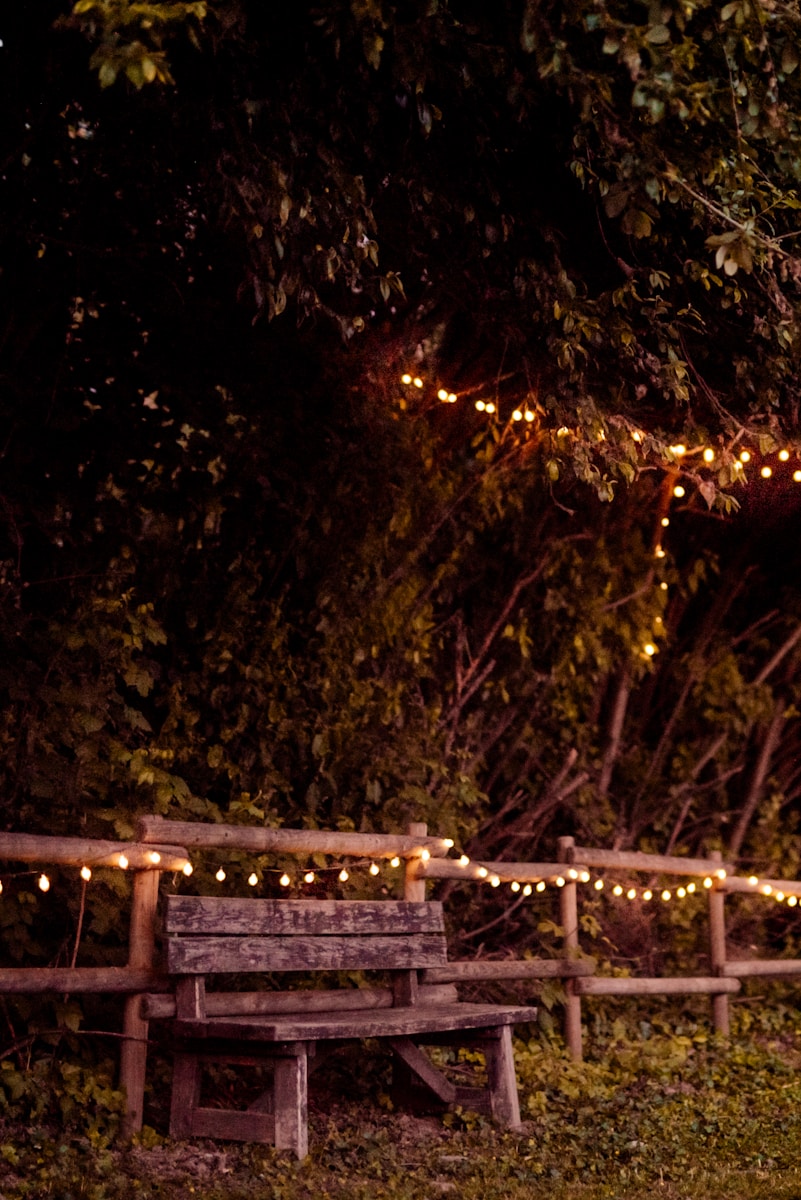How to Add Garden Lighting for Evening Ambience
Why Garden Lighting Matters
Garden lighting does more than brighten your outdoor space—it extends the usability of your yard, improves safety, and creates an inviting atmosphere after sunset. Thoughtfully placed lights highlight plants, paths, and structures, turning your garden into a magical retreat.
Whether you’re hosting outdoor dinners or enjoying a peaceful night on the patio, the right lighting transforms your landscape. With a mix of form and function, garden lighting allows you to enjoy your outdoor haven long after the sun sets.
Types of Outdoor Garden Lighting
There are several categories of garden lighting, each serving a unique purpose. Ambient lighting sets the mood, task lighting improves visibility for cooking or dining, and accent lighting highlights features like statues, water elements, or trees.
Popular types include string lights, path lights, spotlights, lanterns, and recessed deck lights. Solar, low-voltage, and LED options provide energy-efficient solutions for every budget. Choosing a mix of lighting types creates depth and contrast, enhancing both aesthetics and functionality.
Planning Your Garden Lighting Layout
Before installing fixtures, walk through your garden at night to identify key areas to illuminate. Focus on entries, pathways, seating zones, and focal features. Sketch a layout showing existing structures and where lighting can make the biggest impact.
Balance light placement to avoid harsh shadows or overly bright spots. Aim for soft, overlapping pools of light rather than a floodlit yard. A good garden lighting plan highlights natural beauty while improving safety and flow.
Using Lighting to Highlight Garden Features
Accent lighting draws attention to your garden’s best features. Use uplights to emphasize trees or sculptures, or downlights to mimic moonlight under branches. Wash lighting softly illuminates walls or fences, while underwater lights bring drama to ponds and fountains.
Backlighting can create silhouettes for architectural plants, while cross-lighting adds dimension. With strategic placement, garden lighting showcases your landscape’s textures, layers, and colors—even in the dark.
Pathway and Step Lighting for Safety
Well-lit paths and steps reduce the risk of trips and falls while guiding guests through your garden. Install stake lights or low-profile fixtures along walkways and borders. Use step lights recessed into risers or nearby structures for added visibility.
Spacing is key—lights should be evenly placed to eliminate dark gaps without glare. Choose durable, weather-resistant materials and aim lights downward to minimize light pollution. Safe navigation combined with ambient glow enhances both practicality and beauty.
Choosing Energy-Efficient Lighting Options
Energy efficiency is crucial in sustainable garden lighting. Solar lights are a popular choice—they charge during the day and automatically illuminate at night, requiring no wiring. LED bulbs, known for their long lifespan and low energy use, are ideal for most applications.
Low-voltage systems provide a balance of brightness and efficiency, especially for more permanent installations. Using timers, motion sensors, and dimmers allows for even greater energy savings. These choices not only reduce your environmental impact but also cut long-term electricity costs.
Creating Mood with Ambient Lighting
Ambient lighting sets the tone for evening gatherings and relaxing nights. String lights, lanterns, and post-mounted fixtures create a soft, warm glow that invites you to linger. Drape string lights over patios, weave them through pergolas, or suspend them between trees for a cozy effect.
Use frosted bulbs or warm white LEDs to soften light and reduce harsh shadows. When done well, ambient garden lighting enhances comfort and transforms outdoor spaces into serene extensions of your home.
Layering Light for Depth and Drama
Just like interior design, layered lighting adds dimension to your garden. Combine ambient, task, and accent lighting to create zones and highlight textures. Layering ensures your space is not only functional but visually captivating from every angle.
For example, use path lights for navigation, uplights to emphasize trees, and hanging lights over dining areas. Adjust brightness across layers for a dynamic effect that feels intentional, balanced, and atmospheric. Layered garden lighting helps your outdoor space come alive after dark.
Controlling Outdoor Lighting Systems
Modern garden lighting systems offer smart controls for convenience and efficiency. Use timers to automate daily schedules, or install motion sensors to light up paths as needed. Smart plugs and Wi-Fi-enabled bulbs let you adjust settings via mobile apps or voice commands.
For large gardens, consider zoned lighting systems with separate controls for different areas. These innovations make managing garden lighting easier while enhancing security and reducing unnecessary energy use.
Blending Fixtures into Your Landscape Design
The best garden lighting fixtures blend seamlessly with their surroundings. Choose materials and colors that match your garden’s style—bronze or copper for rustic themes, black or stainless steel for modern designs. Hide cables or mount fixtures discretely to maintain clean lines.
Recessed lights, low-profile path lights, and subtle wall sconces preserve the natural feel of the space. Decorative lanterns and sculptural lighting add personality without clashing. A harmonious integration ensures that your lighting complements, rather than competes with, your garden’s beauty.
Accentuating Water Features and Plantings
Water elements become captivating focal points when lit at night. Submersible lights highlight ripples, reflections, and movement, adding drama to fountains, ponds, or waterfalls. Place warm-toned lights at the base or behind rocks for a natural, glowing effect.
For plantings, direct soft spotlights or uplights at ornamental grasses, palms, or sculptural shrubs to create dramatic silhouettes. Gentle lighting enhances color and texture without overpowering. Garden lighting placed near water and greenery turns your landscape into an enchanting nighttime escape.
Using Lighting to Extend Outdoor Living Spaces
Strategic lighting extends your living space beyond your home’s walls. Add pendant lights above outdoor tables, sconces on house walls, or deck lights beneath railings. These elements make patios, decks, and pergolas feel like true outdoor rooms.
Layer in task lighting for cooking or reading and ambient lighting for conversation. The goal is to maintain function while fostering comfort and charm. Properly placed garden lighting supports evening entertainment, quiet lounging, or spontaneous stargazing—without needing to retreat indoors.
Integrating Seasonal Lighting Displays
Update your garden lighting with the seasons to keep things fresh and festive. In summer, solar stake lights and twinkle strings enhance evening blooms. In fall, highlight ornamental grasses and autumn foliage with warm hues. For winter, add sparkle with holiday lights or uplights on evergreens.
Seasonal lighting isn’t limited to holidays—it reflects nature’s rhythm and enhances mood. By rotating themes and colors, your garden remains vibrant year-round. Decorative flexibility makes garden lighting an evolving element of your landscape design.
Common Garden Lighting Mistakes to Avoid
Avoid overly bright lighting that disrupts the natural ambiance or contributes to light pollution. Don’t place fixtures too close to plants, which can overheat or look harsh. Overuse of a single type of lighting often leads to flat, uninspired results.
Plan with balance, and test placements before committing. Consider your neighbors and wildlife by using shields and warm-toned LEDs. Avoiding these common mistakes ensures your garden lighting enhances, rather than overwhelms, your landscape after dark.
Designing a Garden That Glows
Garden lighting is more than a utility—it’s a design tool that transforms outdoor spaces into welcoming nighttime retreats. With the right mix of ambient, accent, and task lighting, you can showcase beauty, ensure safety, and enjoy your garden long after dusk.
Plan your layout with intention, choose energy-efficient fixtures, and let light guide your evenings. Whether you’re entertaining, relaxing, or simply admiring your landscape, garden lighting creates a space that glows with warmth, style, and magic under the stars.
Frequently Asked Questions
What is the best type of garden lighting for ambience?
For ambient lighting, string lights, lanterns, and low-voltage LED fixtures work best. They provide soft, diffused light that enhances the mood without overwhelming the garden. Warm white LEDs are ideal for a cozy glow, while solar lanterns offer energy efficiency and mobility. Position ambient lighting near seating areas, pathways, or pergolas to create atmosphere and visual interest. These lights aren’t meant to illuminate everything but rather to define key zones and make the garden feel inviting after dark. With proper placement, ambient garden lighting enhances the overall look and feel of your outdoor space.
How do I install garden lighting safely?
Safe installation begins with choosing outdoor-rated fixtures and waterproof connections. Use low-voltage systems to reduce risk, especially in damp environments. For wired setups, consult a licensed electrician, particularly when working with buried cables or connecting to your home’s main power. Always follow manufacturer instructions and consider using a transformer for voltage control. Solar-powered and battery-operated lights offer a simple, safe DIY alternative. Secure fixtures firmly and avoid placing cords where they may be tripped over. Proper planning and weatherproof components ensure your garden lighting system remains both safe and long-lasting.
How can I light my garden without electricity?
You can light your garden without electricity using solar-powered lights, candles, battery-operated lanterns, or rechargeable LED fixtures. Solar garden lighting is the most popular choice—it charges during the day and activates at night automatically. Look for solar path lights, string lights, or hanging lanterns to cover different areas. These options are eco-friendly, budget-conscious, and require no wiring. For temporary events, flameless candles and battery fairy lights add charm. These no-electricity solutions make it easy to enhance evening ambience, even in remote or rental locations where wiring isn’t practical.
How do I prevent garden lights from disturbing wildlife?
To reduce disruption to wildlife, use shielded fixtures that direct light downward and choose warm white bulbs under 3000K. Avoid blue-toned or overly bright LEDs, which can disorient nocturnal animals. Motion-activated lights are another eco-friendly choice, offering illumination only when needed. Install lights away from nesting areas or water features where wildlife is active. Minimize the number of lights and turn off decorative lighting overnight. Thoughtful garden lighting allows you to enjoy your space without negatively impacting the surrounding ecosystem, preserving the natural behavior of local fauna.
Can I automate my garden lighting system?
Yes, you can automate your garden lighting using timers, photocell sensors, or smart home technology. Timers let you schedule on/off times, while dusk-to-dawn sensors activate lights based on natural light levels. Smart plugs and Wi-Fi-enabled fixtures integrate with apps or voice assistants like Alexa or Google Home. These tools offer convenience, improve energy efficiency, and give you greater control over your lighting setup. Automation is especially helpful for maintaining consistent ambience and security without daily adjustments, making your garden lighting both functional and effortless.
© 2025 GardeningandDecor.com. All rights reserved.



